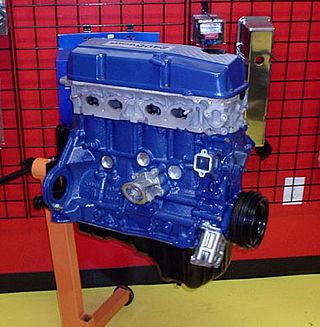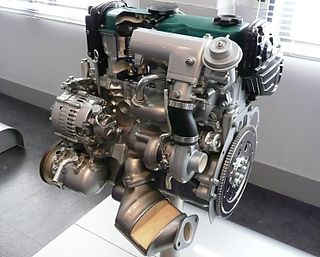
The VQ is a family of V6 automobile petrol engines developed by Nissan and produced in displacements varying from 2.0 L to 4.0 L. Designed to replace the VG series, the all-aluminium 4-valve per cylinder DOHC design debuted with Nissan's EGI/ECCS sequential multi-point fuel injection (MPFI) system. Changes from the VG engine include switching to a timing chain from a timing belt, and relocating the water pump from the outside of the engine to inside the timing cover where the pump is driven by the timing chain. Later versions featured various improvements, such as variable valve timing, and NEO-Di designated VQ engines replace MPFI with direct fuel injection.

The VG engine is a family of V6 engines designed and produced by Nissan between 1983 and 2004.

The KA engines were a series of four-stroke inline-four gasoline piston engines manufactured by Nissan, which were offered in 2.0 and 2.4 L. The engines blocks were made of cast-iron, while the cylinder heads were made of aluminum.
The Nissan H series of automobile engines is an evolution of the Nissan "R" engine which was based on the 1.5-liter, three-main bearing "G" engine used in the 1960s. Both inline-four and inline-six versions were produced. It is a pushrod OHV design with iron block, early models with an iron head, later models with aluminum head. Versions of this motor have been used in many Nissan autos and forklifts, well into the eighties and a version called H20II was in production until 2003. The SD diesels are based on this series of motors

The Nissan L series of automobile engines was produced from 1966 through 1986 in both inline-four and inline-six configurations ranging from 1.3 L to 2.8 L. It is a two-valves per cylinder SOHC non-crossflow engine, with an iron block and an aluminium head. It was the engine of the Datsun 510, Datsun 240Z sports car, and the Nissan Maxima. These engines are known for their reliability, durability, and parts interchangeability.

The Nissan Z engine is a series of automobile and light truck four-cylinder engines that was engineered by Nissan Machinery, manufactured by the Nissan Motor Company from 1979 through August 1989. All Z engines had 4 cylinders, a total of 8 valves and a single overhead camshaft (SOHC). Displacements ranged from 1.6 L to 2.4 L.The Z series' engine blocks were nearly identical to those of the earlier L Series with the exception of the Z24. While the Z16 and Z18 engines had a deck height similar to the earlier L13/L14/L16/L18 variants, the Z24 had a taller deck height to accommodate a longer stroke. The most notable difference between the Z-series engine and its predecessor was the introduction of a new crossflow cylinder head which reduced emissions by moving the intake ports to the right side of the engine opposite the exhaust ports. This change allows the exhaust port velocity to more effectively scavenge the cylinder and reduce reversion pulses to enhance induction. This change also limits maximum valve lift/lobe lift profiles rendering the cylinder head and valve train configuration undesirable for high-performance uses. The Z series evolved into the NA and KA engines which, along with the smaller CA series, replaced the Z series.

The Prince G-series engine was the company's only straight-four and straight-six engines which began production in 1955. A number of variations were made, with both OHV and OHC heads. A diesel four-cylinder with 1.9 L (1,862 cc) was also built, called the D-6. The G series was used in the Skyline, the Laurel, and the Gloria from the 1950s to the early 1970s.

The Nissan Caravan is a light commercial van designed for use as a fleet vehicle or cargo van and manufactured by Nissan since 1973. Between 1976 and 1997, a rebadged version of the Caravan sold as the Nissan Homy, which was introduced as an independent model in 1965. Outside Japan, the Caravan was also sold as either the Nissan Urvan or Nissan King Van, or earlier with Datsun badging.

The Nissan RD engine series is basically a Nissan RB engine design, except that it is only a single overhead cam six-cylinder diesel engine. It was the successor to the Nissan LD and SD six-cylinder engines and was joined by the six-cylinder Nissan TD engine.

The MA is a straight-4 SOHC 0.9 L, 1.0 L, or 1.2 L engine first introduced in 1982 by Nissan, intended primarily for the K10 series Micra/March model. It shares design similarities with the older E engine, with an 8-valve hemispherical cylinder head but differs in that it uses an aluminium cylinder block. Unusually, the specified ignition timing for the MA10 running on the specified 90 RON gasoline was 2 degrees after top dead centre, reflecting a very high flame speed in the compact combustion chambers.

The Toyota KD engine series is a diesel engine produced by Toyota which appeared in 2000.
The Nissan ZD30 engine family is a 3.0-litre inline-four cylinder diesel engine with a bore and stroke of 96 mm × 102 mm, that replaced the Nissan QD, BD and TD engines. At Renault it also replaced the Sofim 8140 engine and is the only truck diesel engine which remained with Nissan Motors when they sold Nissan Diesel to Volvo trucks in 2007.

The Nissan CD engine is a diesel version of the Nissan CA engine that replaced the Nissan LD four-cylinder engine. They have a cast-iron block and alloy head. It was used from 1980 to the late 1990s until it was replaced by the Nissan YD engine.

The Nissan NA family of straight-four engines is a series of engines manufactured by Nissan. It is the replacement of the Z series, on which its design is based, and is mostly used in commercial vehicles due to its use of Liquefied petroleum gas for fuel on engines with a "P" suffix code.
The Nissan TB straight-six petrol engine was released in 1987 as the TB42. Bore and stroke were 96 mm × 96 mm. Cubic capacity was 4,169 cc displacement). The engine was released with a two-barrel carburettor and a point type distributor. It was used in the Nissan Patrol Y60 and Y61 series.
The BD is an automotive diesel engine produced by Nissan Diesel. BD is specified as a 4-cylinder, direct fuel injection, water-cooled naturally aspirated engine.
The Nissan FD engine is used primarily for Nissan Truck and Bus commercial vehicles. It is of an inline-four layout.

The Nissan VRH engine family consists of several racing engines built by Nissan Motor Company beginning in the late 1980s. All VRH engines are in a V8 configuration, with either natural aspiration or forced induction. Some VRH engines are loosely based on Nissan's production V8 engine blocks, including the VH and VK engines, while others were designed from the ground up for racing and share no components with production blocks.
The Nissan TD series is a series of diesel engines manufactured by Nissan. All TD-series engines are inline engines; most versions are four-cylinders aside from the six-cylinder TD42. They have cast iron blocks and crossflow heads; the combustion chamber design is a swirl-chamber design with indirect injection. The valves are pushrod-actuated, and the engine has two valves per cylinder; the camshaft is driven by a set of gears. The engines are generally deemed durable.













